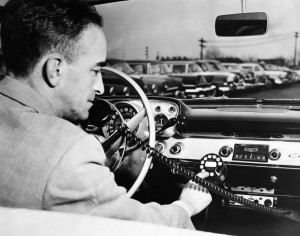
We know that Albany was in on some great technological breakthroughs – Joseph Henry’s discovery of electrical induction and creation of the first telegraph signal, John Wesley Hyatt’s invention of one of the earliest plastics. Turns out, we were on the map for one of the early experiments in what was then called the mobile radiotelephone – something like a cell phone. This AP wire story from the Schenectady Gazette on Dec. 19, 1945, lays out the hopeful details of a future where drivers are paying no attention to the road:
CHICAGO, Dec. 18 (AP)–The Bell system announced plans today for extensive service trials of mobile radiotelephone service along three inter-city highway routes between Chicago and St. Louis, New York, Albany and Buffalo, and New York and Boston.
When these services are established, the company said, it will be possible for any suitably equipped vehicle on these routes or any boat on adjacent waterways to make and receive calls from any telephone connected to lines of the Bell system. Transmitting and receiving stations needed for the service will be located along the routes.
The company said it planned to make the trials under actual operating conditions, and that a number of companies had indicated desire to participate, including truck lines, bus lines, long distance movers, and utilities. It was believed several hundred vehicles would be equipped initially along the three routes.
Highway mobile radiotelephone service will operate like this:
Calls will be handled by mobile several [sic] telephone operators, and conversations will travel part of the way by telephone wire and part by radio. A caller in Chicago wanting to talk to the occupant of a certain automobile between Chicago and St. Louis would call long distance, ask for mobile service operator, and give her the call number of the vehicle.
The operator would route the call over telephone wires to one of the transmitting-receiving stations on the highway, which would send the signal to the vehicle by radio. The car operator then will receive an audible visual signal and can operate a push button which permits him to switch from talking to listening.
The occupant of the mobile unit can originate a call by picking up his phone, ascertaining the circuit is not in use, and pushing the talk button. The mobile service operator will come on the line and get the number the caller requests.
Radiotelephone photo by AP; posted at Forbes.com.

Leave a Reply